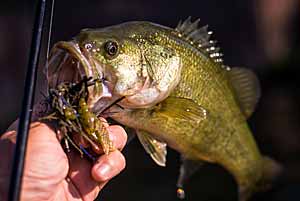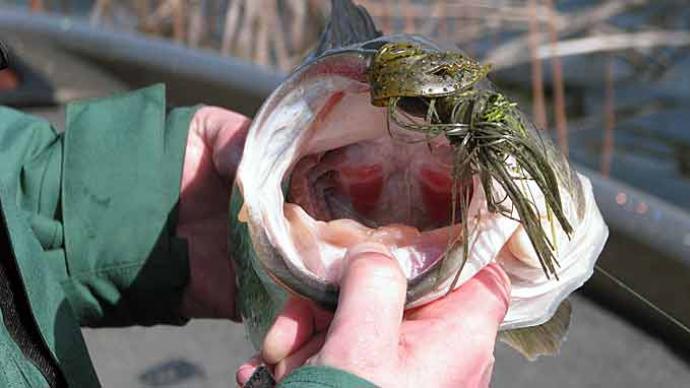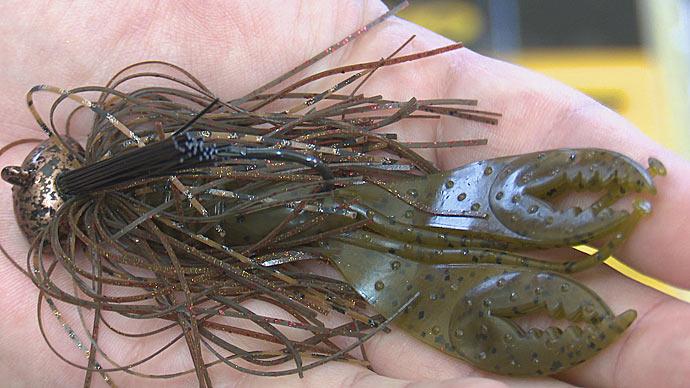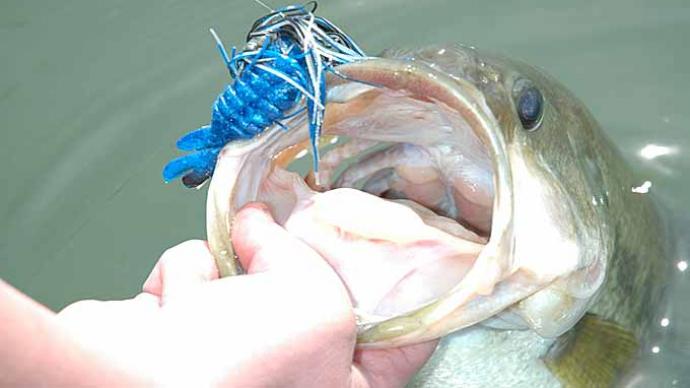
Many anglers associate jig-n-pig fishing with flipping and pitching the baits to shallow visible cover. In truth, I'd estimate that most anglers use the bait this way. If employed, I'll tell you that the jig-n-pig can be a fantastic deeper water lure.
Just as in any other form of deep water fishing, the most important traits to look for are bottom structure and the presence of cover. Bait becomes secondary at this point. The jig is one of the best baits you can use to catch deep bass and figure out where they are located. A jig in deep water becomes a fish finder by this. You can bang it into things to get a feel for what exactly is down there when you attempt to catch fish on it.
I use the jig to explore and search for good structure along weed lines in my local lakes. Much of this jig fishing is done in water about 12 to 15ft deep. This may not seem extremely deep but consider that more times than not, jig fisherman concentrate their jig throwing in water that is shallower than 4ft deep.
Lures
I generally use grass jigs in either 3/8oz or 1/2oz. The grass jig has an angular rocking head that allows it to come through the weeds without hanging up, and once it touches down on the bottom, it rotates the hook upward in the fighting crawfish position. The larger size is a little heavy for light tackle fishing, but the extra weight is a plus in getting the bait down quickly. Color choice depends on both water clarity and forage. Generally, I like four colors: black, brown, black/blue/purple, and roadkill. I don't think I've used any other color in the last couple of years sans black and blue. I use some hand-poured trailer, generally a Muscle Craw or Al's worms Crazy Trailer. I feel that the scented and salted chunks give me a little more time to recognize a strike in deeper water and to set the hook. I employ a rattle only a tiny amount of the time, which is only in highly stained water. I mean minimal, maybe 1 to 2 percent of my total jig fishing in a year.
Rod and Reel
I use a 7-foot medium casting rod with a soft tip made by Kistler. I prefer the He70MC Helium LTA. It has enough length for good leverage and has enough tip sensitivity to let me know exactly what is going on below the surface. I also opt for a He70MHC which is the medium-heavy Helium. I match this up with a Shimano Scorpion 1001 reel that features a quick retrieve and is relatively small in my hands. It is a perfect balance.
I started using fluorocarbon line on my jigging outfits this year. First, I wanted to eliminate line stretch. Next, I wanted to utilize a clear line that I felt would not betray me as far as to look unnatural, and finally, I wanted a line with excellent abrasion resistance. After all, I would use this bait around the cover that could have its way with lesser abrasion-resistant lines. My choice this season is Berkley Vanish. I used 14-pound Vanish almost all year for my deeper water jigging.
Retrieve
Once I locate a piece of structure I feel is worthy enough to work, I get the bait down on top of it and impart minimal action. Often I just let the boat rock, which makes the bait pulse. If I move it on my own, I gently pulse the rod tip by moving it only a few inches at a time. I'm more or less slowly swimming the bait through the bottom structure. The most important thing about this retrieve is not to overwork the jig. Slow and steady is the game's name here, even in the heat of summer. Please don't give the bait too much action as I recognize that my bites decrease as I attempt to fish faster. This may be that I'm picking the jig up off of the bottom and out of the strike zone.
The Strike
As with most jig fishing, some guys have a terrible time recognizing when a bass has mouthed their jig. I can tell you that while deep water jig fishing, you might experience more pressure bites rather than easily detectable flat-out thumps. I use a method that I call "weighing the line" to detect strikes. It is essential to know what your bait feels like at the end of your line without a fish. A 1/2oz jig feels like a 1/2oz jig. If I'm working it and I lose contact with it, or it suddenly feels heavy, I most likely should set the hook because bass has the jig. I've come to recognize that many of the strikes I get while deepwater jigging feels like added weight or pressure. Sometimes you will get thumped hard as some fish whack the jig even in deep water, but this isn't the norm. Jig fishing is one of those techniques in that you should keep a taut line without slack to be most effective.
Where to employ it
I have several deep ponds in my area. One such pond it banded with lily pads its entire perimeter. The exciting thing about it is that those pads form edges right over deep water. I can drop a jig to the edge of the pads, and it will sink into 12 to 15 feet of water. This is interesting because the pad stems form a unique cover wall that bass seems to hold on to. I've had spectacular results at this place, catching several hundred bass in only a few trips' time.
Why it is so effective
I believe that most anglers set out and beat the banks because the bass are concentrated in the shallows many times in the season. This includes anglers who know what they are doing and those who don't. It's just easier to target those areas that contain visible cover. I know that some bass regularly resides in deeper areas, although you can't just go into the middle of the lake and expect to find bass. Instead, there has to be something to attract and hold those fish in the deeper areas. The cover that the deep weed lines afford to fish has that power. Consider that most all anglers concentrate on shallow fish, and you can see that these deeper fish may be less seasoned to pressure and ultimately more willing to strike.
Give deeper water jigging a serious shot. I've experimented with it in the past and have done well. This past year I did it a lot, and it really paid off for me in numbers of fish that I almost didn't realize existed in these areas.




